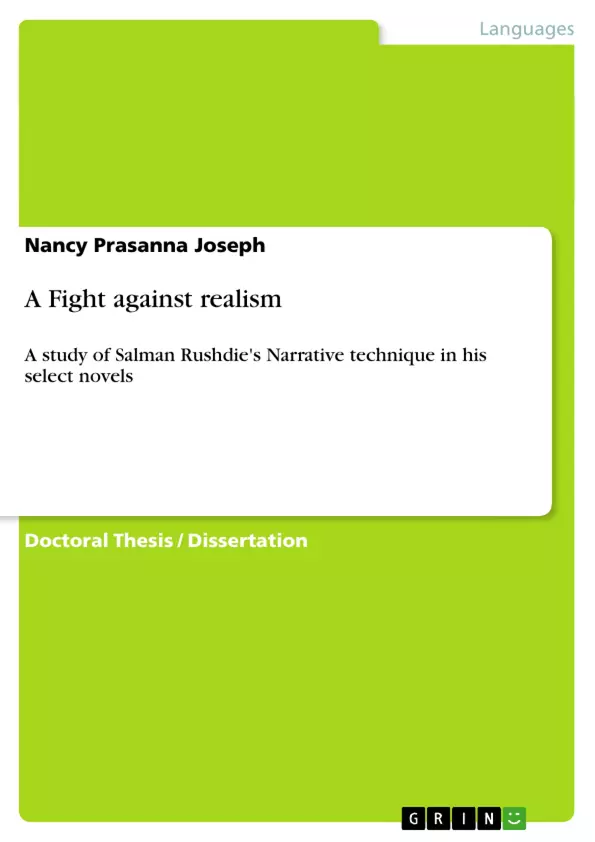Salman Rushdie (born Ahmed Salman Rushdie on June 19, 1947, in
Bombay, India) is an Indian-born British essayist and author of fiction, most of which is set on the Indian subcontinent. He grew up in Bombay (now Mumbai) attended Rugby School, Warwickshire, then King’s College, Cambridge in England. Following an advertising career with Ayer Barker, he became a full-time writer. His narrative style, blending myth and fantasy with real life, has been described as connected with magic realism. His writing career began with Grimus, a fantastic tale, part-science fiction. His next novel, Midnight’s Children, however, catapulted him to literary fame and is often considered his best work to date. It also significantly shaped the course Indian writing in English was to follow over the next decade. This work later awarded the ‘Booker of Bookers’ prize in 1993 after being selected as the best novel to be awarded the Booker Prize in
its 25 years. Midnight’s Children is a 1981 novel by Salman Rushdie. It centers on the author’s native India and was acclaimed as a major milestone in Indian writing. Midnight’s Children is an allegory for the events in India after independence in 1947. The protagonist and narrator of the story is Saleem Sinai, a telepath with a nasal defect, who is born at the exact time that India became independent. Saleem Sinai’s life then parallels the changing fortunes of the country after independence. The novel is also an expression of the author’s own childhood, his affection for the city of Bombay (now Mumbai) of those times, and the tumultuous variety of the Indian Subcontinent.
Inhaltsverzeichnis (Table of Contents)
- Chapter One Introduction
- Chapter Two - Salman Rushdie's Narrative Technique in Midnight's Children
- Chapter Three - Salman Rushdie's Narrative Technique in Shame
- Chapter Four - Salman Rushdie's Narrative Technique in The Moor's Last Sigh
Zielsetzung und Themenschwerpunkte (Objectives and Key Themes)
This work examines the narrative techniques employed by Salman Rushdie in three of his novels: Midnight's Children, Shame, and The Moor's Last Sigh. It analyzes how Rushdie blends myth, fantasy, and real-life experiences to create compelling narratives that explore themes of identity, history, and the complexities of postcolonial societies.
- Narrative Techniques of Salman Rushdie
- Exploration of Identity in Postcolonial Societies
- Blending of Myth and Reality in Literature
- The Influence of History on Narrative
- Cultural Hybridity and the Use of Language
Zusammenfassung der Kapitel (Chapter Summaries)
Chapter One: Introduction: This introductory chapter provides background information on Salman Rushdie and his literary career, highlighting his significant contributions to Indian writing in English. It introduces the concept of magical realism and its prominent role in Rushdie's work, drawing parallels to Gabriel Garcia Marquez.
Chapter Two: Salman Rushdie's Narrative Technique in Midnight's Children: This chapter delves into the narrative techniques employed in Midnight's Children, exploring how Rushdie uses magical realism to parallel India's history and the protagonist's life. It examines the novel's innovative use of language, blending English with native Indian languages.
Chapter Three: Salman Rushdie's Narrative Technique in Shame: This chapter analyzes the narrative techniques used in Shame, examining how Rushdie utilizes magical realism to portray political turmoil in Pakistan. It discusses the influence of modern literature on Rushdie's work and how it shapes his narrative style.
Chapter Four: Salman Rushdie's Narrative Technique in The Moor's Last Sigh: This chapter investigates the narrative techniques employed in The Moor's Last Sigh, focusing on how Rushdie explores commercial and cultural links between India and the Iberian Peninsula. It analyzes the novel's unique blend of history, fantasy, and contemporary social issues.
Schlüsselwörter (Keywords)
Salman Rushdie, magical realism, narrative techniques, postcolonial literature, Indian writing in English, identity, history, myth, fantasy, language, cultural hybridity, Midnight's Children, Shame, The Moor's Last Sigh.
- Citation du texte
- Professor Nancy Prasanna Joseph (Auteur), 2005, A Fight against realism, Munich, GRIN Verlag, https://www.grin.com/document/230567



